| Kingdom | Fungi |
| Phylum | Mucoromycota |
| Order | Mucorales |
| Family | Mucoraceae |
| Genus | Rhizopus |
| Species | R. stolonifer |
| Binomial name | Rhizopus stolonifer |
What is Rhizopus Stolonifer?
- Rhizopus stolonifer is a species of filamentous fungus that belongs to the class Zygomycetes.
- Rhizopus stolonifer is commonly known as black bread mold, as it is often found on bread and other baked goods.
- It is a fast-growing fungus that can quickly spread over moist surfaces, particularly in warm and humid conditions.
- Rhizopus stolonifer has a distinctive appearance, with black, fuzzy patches of mycelium that give it a velvety texture.
- This fungus is an important decomposer in many ecosystems, breaking down dead organic material and recycling nutrients back into the environment.
- Rhizopus stolonifer is also a common cause of food spoilage, as it can grow on a variety of foods, including fruits, vegetables, and grains.
- It is a common cause of fungal infections in humans, particularly in immunocompromised individuals.
- Rhizopus stolonifer is used in the production of tempeh, a fermented soybean product that originated in Indonesia.
- The fungus is also used in the production of certain enzymes, such as amylase and cellulase, which are used in the food industry.
- Rhizopus stolonifer is capable of producing a number of secondary metabolites, including mycotoxins that can be harmful to humans and animals.
- Despite its potential negative effects on human health and food safety, Rhizopus stolonifer is an important organism in many ecosystems and has many practical uses in industry.
Classification of Rhizopus Stolonifer
- Domain: Eukarya – Rhizopus stolonifer is classified as a member of the Eukarya because its cells are organized into complex structures surrounded by membranes and contain nuclei and other organelles bound to membranes.
- Kingdom: Fungi – The monarchy Heterotrophic organisms make up the kingdom Fungi. Rhizopus stolonifer is a non-motile, filamentous, non-chlorophyll-containing fungi that decomposes organic matter.
- Phylum: Zygomycota – Rhizopus stolonifer belongs to the phylum Zygomycota due to its reproductive production of zygospores and parasitic nature.
- Phylum: Zygomycetes – The Zygomycetes lack motile spores and have chitinous cell walls in a coenocytic mycelium.
- Order: Mucorales – Rhizopus stolonifer is a member of the Mucorales due to its rapid growth, extensive hyphae, lack of septa or coenocytic nature, and growth within a substrate. Rhizopus stolonifer is also considered to be a member of the Mucorales because it is an important saprophyte, or an organism that grows and obtains nutrients from decomposing matter.
- Clade: Mucoraceae – Rhizopus stolonifer belongs to the family Mucoraceae due to the presence of the columella, an enlarged extension of the sporangiophore. It resembles a balloon within the sporangium and frequently persists after the spores are released.
- Genus: Rhizopus – Rhizopus stolonifer is a member of the Rhizopus genus because it is a rot-causing fungus with rhizoid-anchored columnar hemispherical aerial sporangia.
- Species: Rhizopus stolonifer – Multiple species of Rhizopus exist, but Rhizopus stolonifer is the only one whose spores are airborne and which grows on bread. Rhizopus stolonifer utilizes rhizoids to anchor itself to the immense variety of substrates it can encounter.
Habitat of Rhizopus Stolonifer
It thrives in mild, humid environments, such as soil, decomposing organic matter, and indoor environments. Rhizopus stolonifer is also commonly observed growing on food, surfaces, and other materials in homes and enterprises.
Rhizopus stolonifer is a decomposer, which means it breaks down organic matter that has died. It is a crucial component of the carbon cycle because it helps return carbon to the soil. Additionally, Rhizopus stolonifer is a pathogen, meaning it can cause disease. It can induce a variety of plant and animal infections, including soft rot and mucormycosis.
Rhizopus stolonifer is a versatile fungus with numerous applications. It is utilized in a variety of industrial processes, including the creation of fumaric acid, lactic acid, and cortisone. It is also used to make tempeh, a traditional Indonesian food derived from soy beans.
Rhizopus stolonifer is found in the following specific habitats:
- Soil: Rhizopus stolonifer is a common decomposer in soil, where it aids in the decomposition of decomposing organic matter.
- Decaying organic matter: Rhizopus stolonifer can also be found growing on decomposing organic matter such as decaying leaves, fruits, and vegetables.
- Indoor environments: Growing on food, surfaces, and other materials, Rhizopus stolonifer is a prevalent sight in homes and businesses.
- Hospitals: Rhizopus stolonifer is also found in hospitals, where it can induce infections in immunocompromised patients.
Morphology of Rhizopus Stolonifer
The following describes the morphology of Rhizopus stolonifer:
- Mycelium: Rhizopus stolonifer’s mycelium is a mass of branching hyphae. The hyphae are coenocytic, which means they have a continuous cytoplasm.
- Stolons: Stolons are lengthy, horizontal hyphae that aid in affixing the fungus to its substrate. Typically, they are white or gray in hue.
- Rhizoids: Rhizoids are short hyphae that resemble roots and acquire nutrients from the substrate. Typically, they are dark brown or black in hue.
- Sporangiophores: Sporangiophores are hyphae that are erect and bear sporangia. They are typically 1 to 3 mm in length and 20 to 25 µm in diameter.
- Sporangia: Sporangia are spherical structures that are composed of spores. They typically range between 100 and 275 µm in diameter.
- Spores: The reproductive elements of Rhizopus stolonifer are spores. Typically, their length and diameter are 13 µm.
Thallus of Rhizopus Stolonifer
- The hyphae are numerous, slender, and freely branched filaments. The hyphae of the fungus are entangled and create a fluffy, white mass that constitutes the thallus. It is known as mycelium.
- During the vegetative phase, it is white as cotton. Nevertheless, it quickly enters the reproductive phase. Numerous black structures resembling pin heads form on the mycelium, giving the entire cobwebby mass a blackish hue, hence the common name black molds.
- Are all hyphae that comprise the mycelium identical? During the initial phase of development, the mycelium is composed of identical hyphae. They continue to exist in the substratum. After a few days of growth, this internal mycelium generates hyphae that migrate to the substrate’s surface to form an aerial mycelium. The latter demonstrates hyphae differentiation and division of labor.
- It consists of three lands of hyphae:
(i) Stolons
- These are hyphae that develop horizontally across the substratum’s surface. They are relatively thicker, larger in diameter, slightly arched, and have fewer branches. The stolons grow swiftly in all directions, causing the mycelium to spread further across the substrate.
- Each stolon originates at the contact site between mycelium and substrate. It runs horizontally for a distance before arching over to meet the substratum further along, forming what appears to be a node-like structure. From the latter emerge new stolons that run across the substratum’s surface and replicate the process.
(ii) Holdfast
- It is a cluster of brown, slender, branched rooting hyphae (Fig. 7.1) that emerge from the lower surface of each stolon’s apparent node and penetrate the starchy substance of the substratum. As they shrink, they secrete an enzyme that digests carbohydrate. Thus, the rooting or rhizoidal hyphae fulfill a dual function.
- They affix the fungus to the substrate and extract water and nutrients from it for the benefit of the entire plant. During the vegetative phase, the mycelium is composed of only these two types of hyphae and is cotton-white in color. As it enters the reproductive phase and develops the third type of hyphae, it becomes spoiled.
(iii) Sporangiophores
- Immediately opposite each holdfast, one or more hyphae with vertical growth ascend into the air. They function reproductively and produce sporangia singularly and terminally. These unbranched, negatively geotrophic, special hyphae are known as sporangiophores.
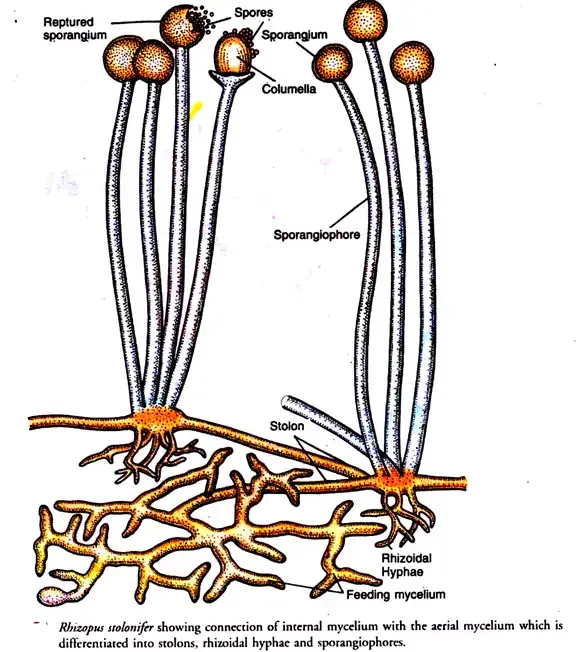
Structure of Thallus
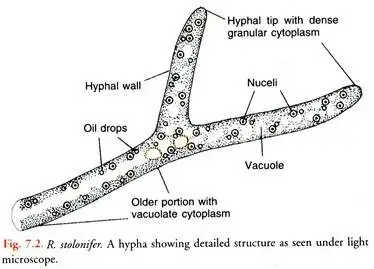
- Mycelium is made up of microscopic, tubular structures called hyphae, which are invisible to the naked eye. Each hypha is surrounded by a restricting hyphal wall made of fungal chitin rather than cellulose. As well as carbon and hydrogen, it also has nitrogen.
- In electron micrographs, its microfibrillar structure and R-Stolonifer-running microfibrils are clearly visible. Under light perpendicular to the surface, the intricate structure of a hypha becomes visible. Water and other solutes can easily pass through the chitinous wall of Rhizopus, much as they can through the cellulose wall of green algae.
- The hyphal wall is lined with a thin plasma membrane, as seen using an electron microscope. The hyphal protoplasm is heavily invested, and the diffusion of solutes into and out of the hypha is tightly controlled.
- The granular hyphal protoplast is packed with tiny nuclei, glycogen, and globules. Protoplasm is quite abundant at the tips of newly formed hyphae. Additionally, tiny sap-filled vacuoles appear further back and eventually merge into a central vacuole in the more mature section.
- Many tiny ribosomes and the tubular endoplasmic reticulum can be found deep into the cytoplasm. The ribosomes come in a standard size. Crystalline mitochondria and mitochondria with two membranes are both found in the cytoplasm. A multilayer nuclear membrane with holes forms the boundary of the nuclei.
- In the expanding hyphae, the cross walls are kept in check. Therefore, the protoplasm is not compartmentalised into individual cells. It persists throughout the mycelium as a whole. Coenocytic describes a plant body or part thereof that develops a multinucleate condition due to the division of nuclei without concurrent wall development.
- Rhizopus hyphae are aseptate and coenocytic. In contrast, the cross walls are associated with reproductive structures and older hyphae. Solid plates make up these septa. Hyphal development occurs solely at the tips.
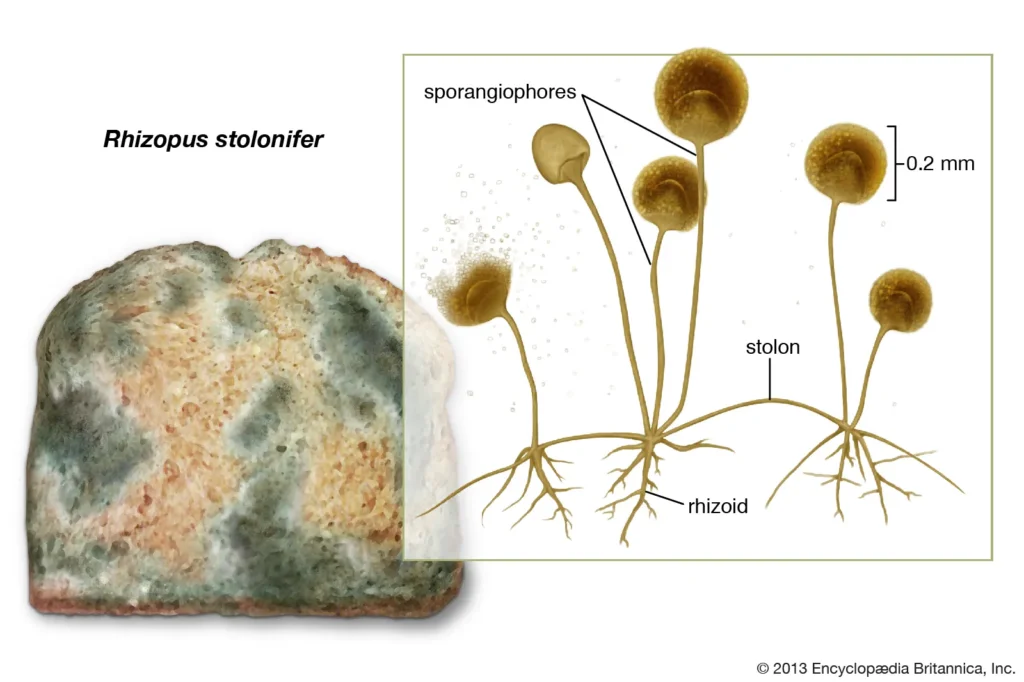
Nutrition of Rhizopus stolonifer
hizopus stolonifer has a wide range of nutrient acquisition options, including:
- Carbohydrates: Rhizopus stolonifer gets most of its energy from carbohydrates. Sugars, starches, and cellulose are all good places to look for them.
- Proteins: Rhizopus stolonifer relies heavily on proteins for nourishment and development. Animal and plant tissues are two of the many potential sources.
- Lipids: Rhizopus stolonifer relies on lipids for proper structure and function. Oils and fats are two of the many places they can be found.
- Vitamins: Rhizopus stolonifer requires vitamins for proper development and growth. Fruits, vegetables, and grains are just some of the places you can find them.
Life Cycle of Rhizopus Stolonifer/Reproduction of Rhizopus Stolonifer
Vegetative, asexual, and sexual reproduction are all possible for Rhizopus Stolonifer.
1. Vegetative Reproduction
- It occurs through fragmentation. The stolon may fragment into two or more microscopic units if it is broken by accident. Each unit is able to develop into mother mycelium.
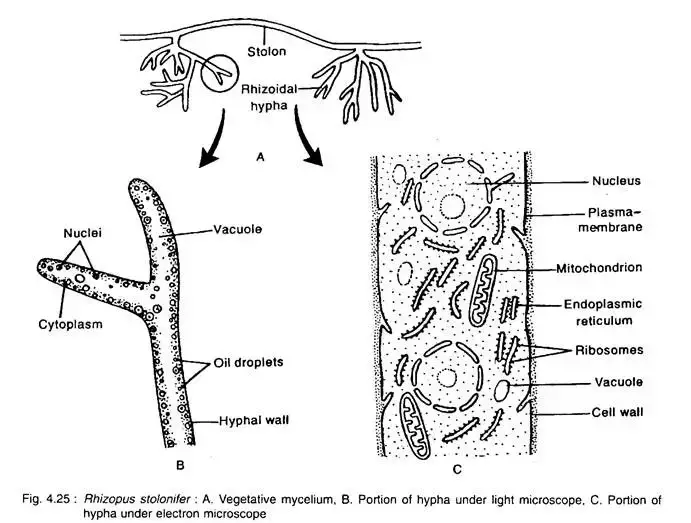
2. Asexual Reproduction
It involves the development of sporangiospores and chlamydospores.
(a) Sporangiospore Formation
- Inside the sporangium, non-motile spores such as sporangiospores and aplanspores are formed under favourable conditions. The sporangium develops singularly at the sporangiophore’s apex.
- The sporangiophore develops as a tuft on the opposite side of the node from the rhizoidal hyphae. Initially, a number of elongated hyphae extend upwards from the upper side of the node to a particular height.
- The nuclei and cytoplasm continue to press towards the apical side, causing the apex of the aerial hyphae to swell. The enlarged portion develops into a large, spherical sporangium.
- With maturation, the protoplast within the sporangium differentiates into a thick, compact layer of multinucleate cytoplasm just inside the sporangia’s wall, known as sporoplasm, and a vacuolated portion with a few nuclei in the centre, known as columellaplasm. Between the sporoplasm and columellaplasm, a series of small vacuoles then appear.
- These vacuoles flatten and unite to produce a continuous cleavage cavity. This is followed by the formation of a septum on the cavity’s interior. With continued development, the septum assumes a domed shape and penetrates the sporangium.
- The protoplast of the sporoplasm is then cleaved into numerous small multinucleate (2-10 nuclei) segments. These segments transform into non-motile globose sporangiospores.
- After spores mature, the sporangium wall hardens and the columella collapses like an inverted cup with an irregular surface. The sporangial wall fragments into multiple pieces, leaving a portion as a collar on the sporangiophore. The spores’ powdery bulk is exposed to the atmosphere.
- If the spores land on a suitable substratum in optimal moisture and temperature, they germinate by germ tube to form new mycelia.
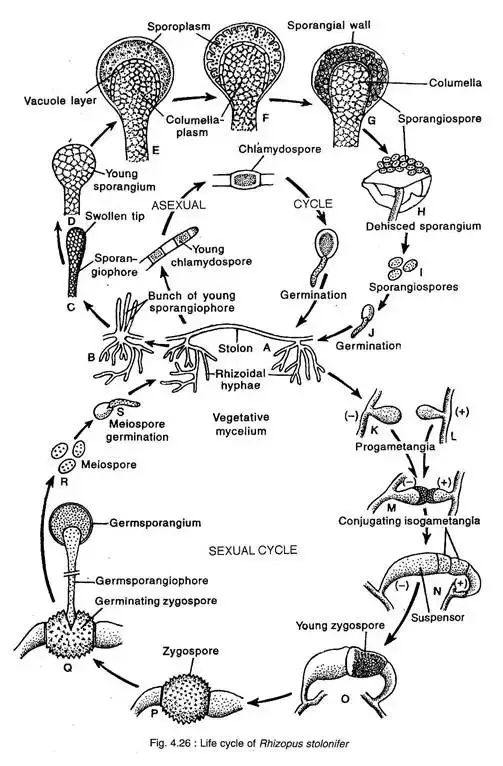
(b) Chlamydospore
Chlamydospores are thick-walled, nutrient-rich, intercalary mycelium segments that result from the septation of mycelium under unfavourable conditions. They become separated when the mycelium connecting them dries up. The chlamydospore germinates and gives rise to a new mycelium upon the onset of auspicious conditions.
3. Sexual Reproduction:
- During adverse conditions, sexual reproduction occurs via gametangial copulation. The gametangia are similar in appearance, but of equal or unequal size, and they give rise to zygospore through conjugation. The majority of Rhizopus species are heterothallic (Rhizopus. stolonifer), while only a few (R. sexualis) are homothallic.
- In heterothallic species, zygospores are produced by the union of two gametangia that have developed from mycelia of compatible strains. In contrast, in homothallic species, the uniting gametangia develop from mycelia that originated from a single spore.
- When heterothallic species are cultured, two mycelia of compatible strain approach one another, and the mycelia produce progametangia. The apical regions of both progametangia are in close proximity to one another. Each progametangium’s nuclei and cytoplasm press more and more towards the apical region, which swells with dense protoplasm.
- The posterior region vacuolates. A septum is set down to separate the gametangium-containing apical region from the suspensor-containing basal region. The indeterminate, multinucleate protoplast of the gametangium is referred to as the aplanogamete or coenogamete.
- The extent of the gametangium pairs varies significantly. In some pairings, the uniting gametangia are of equal size, whereas in others they are not.
- After maturation of gametangia, the common wall at their site of contact dissolves and the protoplasts of both gametangia combine to form zygospore. The nuclei of opposing gametangia fuse to form diploid (2n) nuclei, whereas isolated nuclei degenerate over time.
- The juvenile zygospore enlarges and likely secretes a five-layered (two in exospore and three in endospore) thick wall, which rests.
- Following a period of repose, the zygospore germinates. After the outer walls have cracked during germination, the innermost layer emerges and produces a promycelium. The promycelium develops into a stalk-like germsporangiophore and a spherical germsporangium as it matures.
- During zygospore germination, meiosis occurs, and the haploid nuclei form haploid spores similar to sporangiospores within the germsporangium. Meiospores are another name for these spores. After liberation, each meiospore germinates like a sporangiospore and forms new mycelia like the mother thallus.
- Occasionally, the failure of gametangial copulation results in the development of azygospore or parthenospore by a single gametangium. However, it is haploid and its nuclei do not endure meiosis prior to sporulation.
Pathogenesis of Rhizopus stolonifer
Rhizopus stolonifer is a fungus that can cause numerous plant and animal maladies. It can induce soft rot in plants, a disease that causes the plant’s tissues to become soft and mushy. Mucormycosis is a serious infection that can affect the sinuses, airways, and brain in animals.
Uncertainty surrounds the pathogenesis of Rhizopus stolonifer, but it is believed that a number of factors, including:
- Production of enzymes that break down tissue: Rhizopus stolonifer produces a variety of enzymes, including proteases, lipases, and pectinases, that can degrade tissue. These enzymes provide the fungus with the ability to invade and ruin tissue.
- Adhesion to host cells: Rhizopus stolonifer possesses a number of surface proteins that enable it to adhere to host cells. This enables the fungus to establish a foothold within the host and commence growth.
- Evasion of the immune system: Rhizopus stolonifer possesses a variety of mechanisms that enable it to evade the immune system. This enables the fungus to grow and spread without the body’s defences detecting it.
Disease caused by Rhizopus stolonifer
The most common diseases caused by Rhizopus stolonifer are:
- Soft rot: malleable rot is a plant disease that causes the tissues to become mushy and malleable. It primarily affects fruits and vegetables, but can also affect other plant tissues. The fungus generates enzymes that degrade plant tissues, resulting in their softening and decay.
- Mucormycosis: Mucormycosis is a potentially fatal infection that can affect the sinuses, airways, and brain. People with compromised immune systems, such as those with diabetes or cancer, are most susceptible. Through the sinuses, lungs, or skin, the fungus can infiltrate the body. Once inside the body, the fungus can swiftly grow and spread, causing infection and tissue damage.
- Black mold: On food and surfaces, black mould is a type of mould that can develop. It can trigger allergic reactions and respiratory difficulties. Mould generates particles that can be released into the air and inhaled. Spores can induce allergic reactions such as sneezing, coughing, and wheezing when inhaled. Spores can also cause more severe respiratory problems, such as pneumonia, in some individuals.
Treatment of Rhizopus stolonifer
The treatment of Rhizopus stolonifer infection typically involves a combination of antifungal medications and surgical removal of infected tissue. The goal of treatment is to eradicate the fungus and prevent its spread to other parts of the body.
- Antifungal medication: The most commonly used antifungal medication for Rhizopus stolonifer infection is amphotericin B. This medication is usually given intravenously, and it works by binding to the fungal cell membrane, causing it to become leaky and eventually leading to the death of the fungus. The most common antifungal drugs used to treat Rhizopus stolonifer infection are:
- Amphotericin B
- Flucytosine
- Voriconazole
- Posaconazole
- Isavuconazole
- Surgery: Surgery may be necessary to remove infected tissue and reduce the spread of the fungus. This may involve removing the affected tissue in the sinuses or other affected areas. Surgery is typically performed in conjunction with antifungal medication.
- Supportive care: Supportive care, such as oxygen therapy, may be necessary to help manage symptoms and improve overall health. People with weakened immune systems may also require additional treatments to address underlying health issues.
Prevention of Rhizopus stolonifer
Prevention of Rhizopus stolonifer infection primarily involves avoiding exposure to the fungus. Here are some general measures to prevent the growth and spread of Rhizopus stolonifer:
- Maintain good hygiene: Regularly wash your hands with soap and water, particularly before and after handling food. Keep your living space clean and well-ventilated.
- Avoid contact with contaminated soil and organic matter: Wear gloves and protective clothing when handling soil, decaying fruits and vegetables, and other organic matter.
- Properly store and handle food: Store food in clean and dry containers. Avoid eating food that has been sitting out at room temperature for extended periods of time.
- Control blood sugar levels: If you have diabetes, it is important to keep your blood sugar levels under control to reduce the risk of infection.
- Protect your skin: If you have cuts or open wounds, keep them covered with a bandage to prevent infection.
- Seek prompt medical care: If you have symptoms of rhinocerebral mucormycosis, seek medical attention right away. Early diagnosis and treatment can improve your chances of a successful outcome.
Industrial Uses of Rhizopus stolonifer
- Production of citric acid: Citric acid is a mild organic acid used in a variety of food and beverage products as well as some industrial applications. Rhizopus stolonifer is one of the most prevalent fungi utilised in the production of citric acid. The fungus is cultivated in a large tank containing a solution rich in nutrients. As the fungus develops, citric acid is produced as a byproduct. The citric acid is then extracted and purified from the solution.
- Production of ethanol: Ethanol is an alcohol used in numerous products, including alcoholic beverages, petrol, and solvents. Rhizopus stolonifer can be used to produce ethanol via the fermentation process. The fungus is grown in a nutrient-rich solution with added sugar during fermentation. Sugar is converted into ethanol and carbon dioxide by the fungus. The ethanol is then extracted and purified from the solution.
- Production of cortisone: Cortisone is a steroid hormone used to treat numerous medical conditions, including inflammation, arthritis, and asthma. Rhizopus stolonifer can be used to produce cortisone via the fermentation process. During fermentation, fungi are cultivated in a nutrient-rich solution containing glucose. The fungus transforms glucose into cortisone and additional steroids. The cortisone is then extracted and purified from the solution.
- Fermented foods: Rhizopus stolonifer is utilised in the manufacture of fermented foods such as tempeh, sake, miso, and natto. By fermenting soybeans, rice, and other cereals with Rhizopus stolonifer, these foods are produced.
- Bioremediation: Rhizopus stolonifer can be used in bioremediation to purify polluted soil and water. It is capable of degrading numerous pollutants, including pesticides, herbicides, and heavy metals.
- Medicine: Rhizopus stolonifer is being researched as a potential treatment for a number of diseases, including cancer, diabetes, and Alzheimer’s disease.
Cultural Characteristics of Rhizopus stolonifer
- Growth: Rhizopus stolonifer expands swiftly. It can establish a visible colony within twenty-four hours. The fungus flourishes optimally at temperatures ranging from 25 to 30 degrees Celsius. It is also capable of growth at temperatures below 25 degrees Celsius, albeit at a reduced rate. Rhizopus stolonifer cannot thrive at temperatures higher than 35 degrees Celsius.
- Colony morphology: Rhizopus stolonifer colonies are initially white, but as they mature, they turn black. Additionally, the colony is spongy and has a velvety texture. The colony is composed of hyphae, which are thread-like structures that comprise the fungus’s body. The hyphae are initially translucent, but as they mature, they turn black.
- Aerial mycelium: Rhizopus stolonifer produces a dense mat of aerial mycelium. Initially, the aerial mycelium is white, but as it matures, it turns black. The aerial mycelium consists of hyphae that develop above the agar’s surface. The hyphae are responsible for the colony’s furry and velvety texture.
- Sporulation: Rhizopus stolonifer produces sporangia, which are spherical structures containing spores, during sporulation. The sporangia are produced on stalks and are black. The sporangia are produced on the mycelium in the air. When the spores are mature, they are discharged from the sporangia. The spores are disseminated by water and wind.
- Germination of spores: Rhizopus stolonifer spores germinate quickly. They can germinate within twenty-four hours. When the spores come into contact with a moist surface, they germinate. The spores will develop into a new Rhizopus stolonifer colony.
- Mold Morphology: Rhizopus stolonifer is characterised by the presence of rhizoids, stolons, and sporangiophores in its morphology. Rhizoids are root-like structures that affix fungi to their substrate. Stolons are lengthy, filamentous structures that connect rhizoids to sporangiophores. Sporangiophores are the sporangia-bearing branches.
Culture Media Used for the growth of Rhizopus stolonifer
- Potato dextrose agar (PDA): PDA is a culture medium used to cultivate a wide range of fungi. Potatoes, dextrose, agar, and water are used to produce it.
- Sabouraud dextrose agar (SDA): Sabouraud dextrose agar (SDA) is a selective medium used to cultivate yeasts and moulds. It consists of dextrose, agar, and water.
- Malt extract agar (MEA): Malt extract agar (MEA) is a nutrient-rich culture medium used to cultivate a diversity of fungi. It is constituted of malt extract, agar, and water.
- Yeast extract agar (YE): YE is a nutrient-dense culture medium used to cultivate yeasts. Water, yeast extract, and agar are the ingredients.
- Brain heart infusion agar (BHI): BHI is a nutrient-dense culture medium used to cultivate a wide range of bacteria and fungi. It is composed of brain, heart, agar, infusion, and water.
- Tryptic soy agar (TSA): TSA is a nutrient-rich medium used to cultivate a variety of microorganisms. Water, agar, and tryptic soy bouillon are used to create it.
- Synthetic Media: Synthetic media can also be used to cultivate Rhizopus stolonifer. These media are composed of defined chemical components, allowing for precise control over nutrient composition. Examples of synthetic media commonly used for Rhizopus stolonifer include Vogel’s medium and Richard’s medium.
Rhizopus stolonifer under microscope
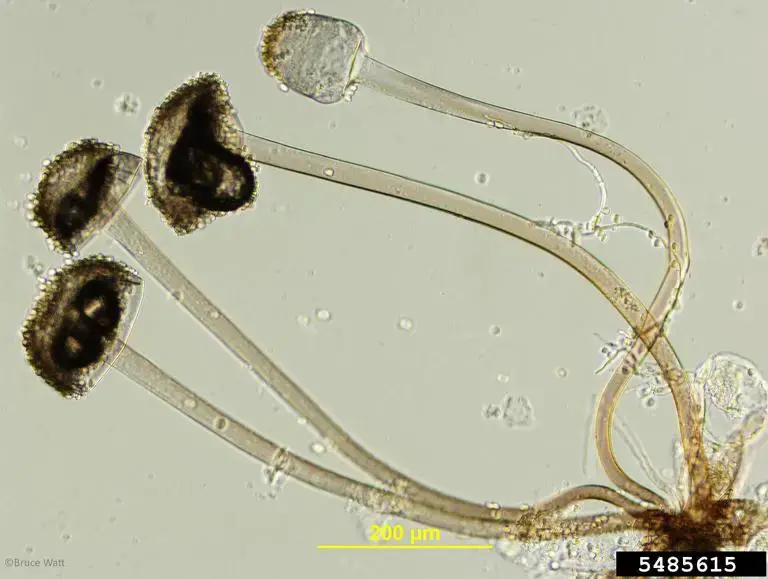
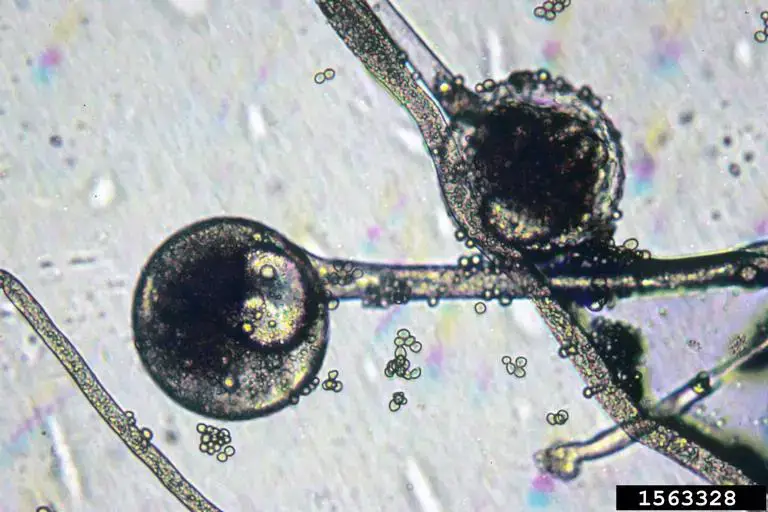
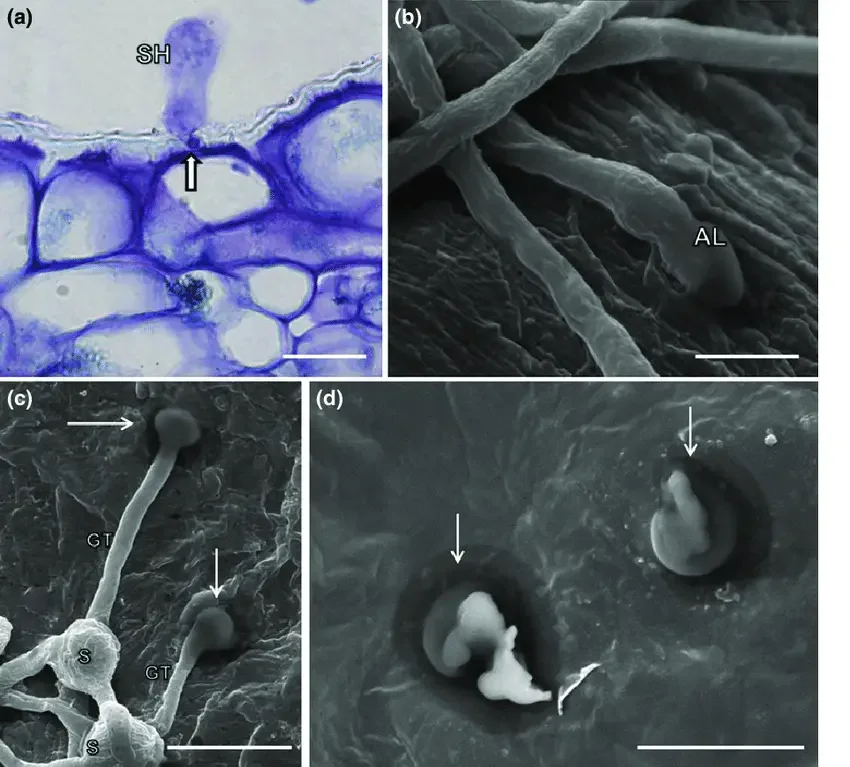
Rhizopus stolonifer facts
- Rhizopus stolonifer, commonly known as black bread mold, is a filamentous fungus belonging to the class Zygomycetes.
- It is a saprophytic fungus, meaning it obtains nutrients by decomposing dead or decaying organic matter.
- Rhizopus stolonifer is a fast-growing fungus with a rapid rate of reproduction, making it one of the most common fungi found in the environment.
- The fungus is known for its distinctive black sporangia, which contain numerous black spores.
- Rhizopus stolonifer has a worldwide distribution and can be found in a variety of habitats, including soil, decaying fruits and vegetables, and compost piles.
- It is an opportunistic pathogen, particularly affecting individuals with weakened immune systems, such as those with uncontrolled diabetes or undergoing immunosuppressive therapy.
- The fungus plays an important ecological role in nutrient recycling by breaking down organic matter and releasing nutrients back into the environment.
- Rhizopus stolonifer is used in the production of various fermented foods, such as tempeh, a traditional Indonesian soy product.
- It is capable of producing enzymes, including amylases and proteases, which have industrial applications in food processing, textile manufacturing, and other industries.
- Rhizopus stolonifer has been studied extensively as a model organism in fungal genetics and physiology due to its rapid growth and ease of cultivation.
FAQ
What is Rhizopus stolonifer?
Rhizopus stolonifer is a filamentous fungus commonly known as black bread mold. It belongs to the class Zygomycetes and is a saprophytic organism that decomposes dead or decaying organic matter.
What are the symptoms of Rhizopus stolonifer infection?
Symptoms of Rhizopus stolonifer infection typically include headache, facial pain, fever, sinus congestion, black lesions on the nasal bridge or palate, and vision loss. If left untreated, the infection can spread and become life-threatening.
How is Rhizopus stolonifer infection treated?
Treatment of Rhizopus stolonifer infection usually involves a combination of antifungal medications, such as amphotericin B, and surgical removal of infected tissue. Early diagnosis and prompt treatment are crucial for a successful outcome.
How can I prevent Rhizopus stolonifer infection?
Preventing Rhizopus stolonifer infection involves practicing good hygiene, avoiding contact with contaminated soil or organic matter, properly storing and handling food, controlling blood sugar levels (for individuals with diabetes), protecting open wounds, and seeking medical care if symptoms of infection occur.
What are the industrial uses of Rhizopus stolonifer?
Rhizopus stolonifer has several industrial uses. It is used in the production of enzymes, such as amylases and proteases, for various industrial processes. It is also involved in the production of organic acids, bioremediation of environmental pollutants, and the production of tempeh.
What are the cultural characteristics of Rhizopus stolonifer?
Cultural characteristics of Rhizopus stolonifer include fast growth with cottony or fluffy colonies that can range in color from white to grayish-brown. It produces tall, branched sporangiophores that bear black sporangia containing spores.
What culture media is used for the growth of Rhizopus stolonifer?
Common culture media used for the growth of Rhizopus stolonifer include Potato Dextrose Agar (PDA), Sabouraud Dextrose Agar (SDA), Malt Extract Agar (MEA), Czapek-Dox Agar, and synthetic media like Vogel’s medium and Richard’s medium.
What are some tips for growing Rhizopus stolonifer on culture media?
To grow Rhizopus stolonifer on culture media, it is important to provide suitable conditions such as a nutrient-rich medium, appropriate temperature (20°C to 30°C), and proper hygiene practices to prevent contamination.
How can I identify Rhizopus stolonifer?
Rhizopus stolonifer can be identified by its distinctive black sporangia and spores, the presence of tall sporangiophores, and its rapid growth on suitable culture media. Microscopic examination and molecular techniques can also be used for accurate identification.
What are the benefits of Rhizopus stolonifer?
The benefits of Rhizopus stolonifer include its role in nutrient recycling and its use in various industrial processes, such as enzyme production and bioremediation. It is also used in the production of food products like tempeh.
References
- Graybill, J. R., Najvar, L. K., & Kirkpatrick, W. R. (2018). Rhizopus stolonifer. In Mandell, Douglas, and Bennett’s Principles and Practice of Infectious Diseases (pp. 3119-3124). Elsevier.
- Singh, R. K., Singh, P., & Singh, S. M. (2018). Rhizopus stolonifer: A potential source of industrially important enzymes. In Microbial Enzymes: Roles and Applications in Industries (pp. 173-189). CRC Press.
- Sultana, B., Anjum, T., Chisti, Y., & Banerjee, U. C. (2018). Diverse applications of Rhizopus stolonifer enzymes. Critical Reviews in Biotechnology, 38(2), 238-252.
- Gutarowska, B., & Świątek, M. (2019). Rhizopus stolonifer: A Potential Plant Growth-Promoting Fungus. In Beneficial Plant-Microbial Interactions: Ecology and Applications (pp. 207-220). CRC Press.
- Prasad, M. P., Sangeetha, J., & Gopalakrishnan, V. K. (2020). Rhizopus stolonifer as a Model System for Study of Rhizopus Soft Rot Disease of Taro. In Plant Pathogens: Identification, Detection, and Management (pp. 335-350). Springer.
- https://www.researchgate.net/publication/304602645_EFFECT_OF_CONCENTRATION_AND_pH_ON_THE_PRESERVATIVE_ACTION_OF_CALCIUM_PROPIONATE_AGAINST_BLACK_BREAD_MOLD_RHIZOPUS_STOLONIFER_IN_KERALA
- http://bioweb.uwlax.edu/bio203/2011/olbrantz_chri/reproduction.htm
- https://www.onlinebiologynotes.com/rhizopus-stolonifer-morphology-and-reproduction-of-black-bread-mold/
- https://bio113.weebly.com/rhizopus-stolonifer.html
- https://en.wikipedia.org/wiki/Rhizopus_stolonifer
- https://bio113portfolioleighhobson2.weebly.com/rhizopus-stolonifer.html
- Text Highlighting: Select any text in the post content to highlight it
- Text Annotation: Select text and add comments with annotations
- Comment Management: Edit or delete your own comments
- Highlight Management: Remove your own highlights
How to use: Simply select any text in the post content above, and you'll see annotation options. Login here or create an account to get started.